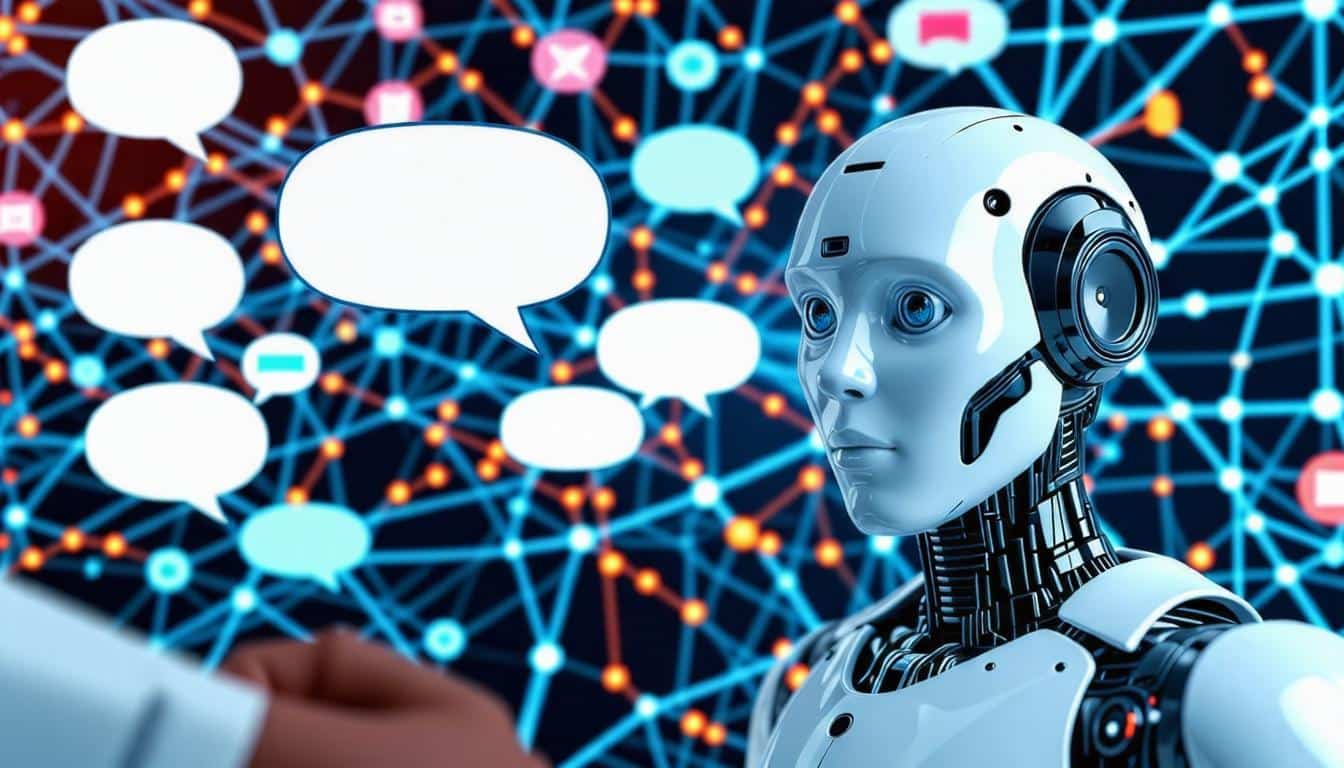Choosing the Right Chatbot App for Your Business Needs
Consider a boutique retailer that successfully expanded its global customer base by incorporating multilingual AI chatbots. When selecting the right chatbot app for your business needs, evaluating is vital to start by identifying your core objectives and evaluating your industry requirements. Look for a platform that offers deep customization, flexibility, and scalability, ensuring it integrates seamlessly with your existing systems and supports your growth plans. Understanding these foundational elements will set you on the path to finding a chatbot solution that truly aligns with your business goals. Effective selection now will determine the future success of your customer engagement strategy.
Key Takeaways
- Conduct a Thorough Needs Analysis: Understand your current performance and identify areas for improvement to select the right chatbot features.
- Evaluate Integration and Scalability: Ensure the chatbot platform integrates with existing systems and is scalable to meet future business needs.
- Assess Chatbot Capabilities: Consider essential features such as omnichannel capabilities, data security, multilingual support, AI-driven responses, and sentimental analysis.
- Examine Data Analytics and Reporting: Look for platforms that provide insights into customer interactions and performance metrics to refine strategies.
- Test and Validate: Conduct thorough testing, including user testing, to uncover and address usability and functional issues.
Identify Business Needs
To choose the right chatbot app for your business, it all starts with identifying your business needs.
A thorough needs analysis will help you understand where your business is currently and where it needs to be.
This involves evaluating your current performance and identifying areas that require improvement.
Evaluate your processes and finances, and gather feedback from your employees to get a clear picture of your company’s status.
Prioritize your needs based on their importance to your business’s advancement and develop a plan to address them.
Consider both internal and external factors affecting your business.
Examine your performance metrics, such as sales data and stakeholder opinions on financial investments.
Use this information to determine specific tasks or areas that could be automated through chatbot integration.
A needs assessment process systematically identifies gaps between current and desired outcomes, which is crucial for making informed decisions about your business needs.
Implementing the right chatbot can lead to improved customer satisfaction by providing instant and personalized support, which is essential for driving business growth.
Conducting regular needs assessments can help your business remain adaptable and responsive to changing external factors.
Key Chatbot Features

Key chatbot features include omnichannel capabilities to engage users across multiple platforms, data security to protect user information, and multilingual support to cater to diverse user bases. An effective omnichannel approach ensures a seamless transition between channels, enhancing customer satisfaction and loyalty by fostering consistency and reducing frictionOmnichannel Experience. Additionally, advanced features such as AI-driven responses, contextual handover to human agents, and chatbot API integration with external systems can further improve the efficiency and effectiveness of your chatbot. Choosing the right chatbot also requires considering its Specific Use Cases, such as writing tasks, coding, or creative support, to ensure it meets your business needs. By leveraging Omnichannel Integration, businesses can unify various communication channels into a single, cohesive platform, streamlining interactions and enhancing overall customer experience.
Essential Chatbot Features
Omnichannel Capabilities: Your chatbot should support interactions across various platforms such as websites, social media, and messaging apps.
- Chatbot Analytics: This feature provides insights into user interactions, helping you improve chatbot performance.
- Data Security: Safeguarding the protection of customer data during interactions is critical.
- Sentiment Analysis and Emotional Intelligence: These features analyze user emotions to provide more personalized and empathetic responses.
- Live Chat Handover: This facilitates a seamless shift from chatbot to human support when needed, guaranteeing complex queries are handled efficiently.
Choosing a chatbot with these essential features helps you enhance customer service and operational efficiency.
By leveraging omnichannel capabilities, you can meet customers where they are, providing a consistent and conversational experience.
With analytics and sentiment analysis, you can refine your chatbot interactions to better serve your customers.
AI chatbots offer tailored and personalized support to customers, improving user engagement on various touchpoints like websites and social media by utilizing machine learning capabilities.
Prioritize these features to maximize your chatbot’s impact.
Chatbots that can answer 80% of standard questions hassle-free significantly reduce the workload of human support agents, allowing them to focus on more complex issues and improve overall customer satisfaction.
Advanced Chatbot Capabilities
To maximize the potential of advanced chatbots, consider their ability to handle high volumes of simultaneous requests, provide efficient responses, and offer 24/7 support.
Operational efficiency improves through the automation of tasks and the reduction in the need for additional staff. By understanding these capabilities, you can choose a chatbot app that enhances your customer service and meets your business needs. AI-powered chatbots utilize Natural Language Processing to process complex user queries effectively. Enterprise chatbots also integrate seamlessly with third-party software, enhancing the flow of information across departments and improving overall efficiency.
The integration of AI chatbots into business operations is a response to the growing trend of automation and digitalization, with the AI chatbot market expected to grow at a rate of 23.3% from 2023 to 2030.
Evaluating Platforms
When evaluating chatbot platforms, you need to weigh more than just AI capabilities; you also have to ponder how well the platform integrates with your existing systems and supports your long-term business goals.
Look for platforms that offer deep customization, flexibility, and scalability, ensuring they can grow and evolve as your business does. By evaluating these factors, you’ll be able to choose a platform that not only automates tasks but also enhances customer satisfaction and drives operational efficiency. A key consideration is the platform’s ability to automate chatbot building using Autobuild AI, which can significantly reduce development time and resources. The integration capabilities of a chatbot platform, which include seamless integration options with a wide range of enterprise systems enterprise system integration, are critical to maintaining smooth operations and ensuring the virtual assistant can access the data it needs. Effective chatbot solutions also consider the deployment channels, such as webchat plugins, mobile web, and native apps, to ensure a comprehensive user experience across various deployment channels.
Evaluating AI Capabilities
Evaluating AI capabilities in chatbot development platforms is essential to ensure that the selected platform can meet business needs and deliver robust, personalized interactions.
Evaluating AI scalability is vital for long-term use, including load handling capacity, feature compatibility, upgradability, AI adaptability, and understanding platform limitations. AI chatbots have a limited understanding of language and concepts, often leading to irrelevant or incorrect answers due to their lack of creativity.
Consider the following key AI capabilities when evaluating chatbot platforms:
- *Speech Recognition*: Enables chatbots to understand and interpret human language, translating spoken words into text.
- *Natural Language Processing (NLP)*: Allows chatbots to understand human language as it’s spoken.
- *Machine Learning (ML)*: Enables chatbots to learn from past data and improve functionalities and responses over time.
- *Prebuilt AI Services*: Some platforms include prebuilt AI services like sentiment analysis and topic modeling for enhanced intelligence.
- *Free-form Text Handling*: Ability to handle conversational inputs beyond predetermined rules.
Evaluating AI capabilities in chatbots verifies that they can provide personalized and efficient customer service.
Interactive evaluation platforms and benchmarking AI performance across various tasks help identify strengths and limitations, certifying that the chosen platform aligns with your business needs and meets AI scalability requirements.
When selecting a platform, it is also important to identify the type of chatbot your business requires, such as rule-based or AI-based chatbots.
Chatbots require careful planning and implementation, including integration with existing customer support systems to achieve seamless data flow and maximize efficiency.
Platform Integration Options**
For seamless connectivity, look for platforms that support endless extensibility, allowing integrations with any platform or software.
Scalability should also be a priority, guaranteeing the platform can adapt to future innovations and growth. Rasa, for example, offers scalable solutions that can be tailored to business needs over time.
By choosing a platform with robust integration options, you can certify that your chatbot can seamlessly integrate with existing systems, deliver high ROI, and support long-term business objectives.
Prioritize features that align with your business needs and consider the vendor’s reputation and support services to make an informed decision.
Excellent customer service is crucial for businesses, which is why chatbot development platforms have become a necessity for offering impeccable customer service.
A comprehensive evaluation process should include assessing a platform’s data analytics capabilities to ensure it can provide valuable insights into customer interactions and chatbot performance.
To maximize effectiveness, consider that NLP-powered chatbots can understand the intent and underlying feelings in a text and respond in a natural and engaging way, making them highly suitable for various business applications.
Selecting Technology

Choosing the right technology for your chatbot is pivotal, as it directly impacts the efficiency and success of your customer interaction strategy.
This decision involves considering several key factors that will guarantee your chatbot meets your business needs and grows with your company.
- NLP Capabilities: Assess the natural language processing capabilities for better communication.
- Ease of Integration: Evaluate the ease of integration with existing systems like CRMs and websites.
- Security and Compliance: Consider the security and compliance features of the chatbot platform.
- Custom Development: Assess whether custom development is required and if the platform supports it.
- Scalability and Flexibility: Guarantee the technology is scalable and flexible to meet growing business needs.
When selecting technology, it’s essential to think about the tech stacks and cloud hosting options.
These choices affect the chatbot’s performance, reliability, and cost-efficiency.
Custom chatbots built on robust tech stacks can offer enhanced scalability and integration options, while cloud hosting guarantees seamless scalability and minimal downtime.
Businesses should prioritize chatbots that can provide 24/7 customer service to enhance customer satisfaction and operational efficiency.
To maximize effectiveness, businesses should also consider implementing chatbots that support hybrid chatbot capabilities, combining both AI-driven and human inputs for more comprehensive customer support.
For optimal performance, it’s crucial to evaluate the pricing models of various chatbot platforms to find the best fit for your budget and business needs.
Testing and Deployment
Testing and deployment are vital phases in the chatbot development process, where the focus shifts from design and development to validation and refinement.
You need to verify your chatbot works as intended by evaluating its functionality, user experience, and performance under different conditions.
Start by defining clear testing objectives, covering aspects such as responsiveness, speed, and accuracy.
Develop exhaustive test cases that include realistic user interactions and edge cases. Automated testing can help you save time and effort, especially for repetitive and large-scale performance testing.
Conduct user testing to uncover functional and usability issues, addressing them promptly to refine the chatbot.
Key types of testing include functional, usability, performance, security, and A/B testing. Thorough testing is essential for chatbots to provide reliable and secure experiences by preventing security threats.
These will help you identify vulnerabilities, guarantee data protection, and optimize performance.
After deployment, continuously monitor your chatbot’s performance, update features based on user feedback, and guarantee scalability and data security.
Effective chatbot validation and performance optimization are vital for delivering a reliable and engaging user experience.
Regularly iterating and refining your chatbot will help you meet your business objectives and satisfy user needs.
Ensuring that the chatbot understands user inputs correctly is critical for providing accurate and relevant responses, which in turn enhances user satisfaction and overall performance.
The global chatbot market is projected to reach $10.08 billion by 2026, emphasizing the need for thorough testing and refinement to stand out in this growing industry.
Implementation Strategies

IMPLEMENTATION STRATEGIES_
- Set clear business goals: Certify your chatbot strategy aligns with your business objectives.
- Identify and segment your audience: Understand who the chatbot will interact with and tailor interactions accordingly. It is crucial to identify the target audience’s demographics and psychographics in order to create a personalized experience.
- Choose the right channels: Integrate your chatbot with platforms relevant to your target audience.
- Design a cohesive customer journey: Map out pain points and opportunities for automation. It is essential to deliver a seamless customer experience as conversational bot solutions automate conversations at scale.
- Refine and update regularly: Monitor performance, gather feedback, and continuously improve the chatbot. To maximize efficiency, consider that chatbots can automate answering repetitive questions to let your team focus on more challenging cases using AI-powered chatbots.
Frequently Asked Questions
How Long Does a Typical Chatbot Development Project Take?
When developing a chatbot, you’ll typically spend 4-12 weeks on the project timeline, divided into several development phases, including planning, design, coding, testing, and deployment, with complexity and integration needs influencing the duration.
What Are the Costs Associated With Maintaining a Chatbot?
You’ll face ongoing maintenance costs ranging from 10% to 20% of the initial development cost annually, plus integration updates and new feature additions, impacting your cost-benefit analysis and ROI expectations, averaging $1,000 to $5,000 per year.
Can Chatbots Work With Sensitive and Confidential Customer Data?
Like a double-edged sword, chatbots can both empower and endanger sensitive customer data. When handling confidential information, you must guarantee robust data encryption and stringent user authentication measures are in place to safeguard trust and compliance.
How Often Should My Chatbot Be Updated With New Features?
You should update your chatbot with new features regularly, ideally once a week, considering your feature roadmap and customer expectations to certify it stays current, accurate, and aligned with evolving user needs.
Do I Need In-House Developers to Implement a Chatbot?
You don’t need in-house developers to implement a chatbot; no-code platforms simplify the process, allowing you to build and deploy chatbots quickly without coding knowledge, reducing development complexity and the need for outsourcing.
Conclusion
Choosing the right chatbot app is a game-changer for your business. By pinpointing your unique needs, evaluating must-haves like customization and NLP, and testing for scalability and security, you’re investing in a seamless user experience. Don’t let outdated tech hold you back. Embrace a platform that grows with you, ensuring your customers always get the best. Make the right choice and tap into a future of effortless engagement and unparalleled success.



